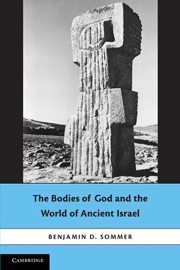Book contents
- Frontmatter
- Contents
- Preface
- Acknowledgments
- Introduction: God's Body and the Bible's Interpreters
- 1 Fluidity of Divine Embodiment and Selfhood: Mesopotamia and Canaan
- 2 The Fluidity Model in Ancient Israel
- 3 The Rejection of the Fluidity Model in Ancient Israel
- 4 God's Bodies and Sacred Space (1): Tent, Ark, and Temple
- 5 God's Bodies and Sacred Space (2): Difficult Beginnings
- 6 The Perception of Divinity in Biblical Tradition: Implications and Afterlife
- Appendix: Monotheism and Polytheism in Ancient Israel
- Notes
- List of Abbreviations
- Bibliography
- Scriptural Index
- Index of Rabbinic Citations
- Subject Index
2 - The Fluidity Model in Ancient Israel
Published online by Cambridge University Press: 15 September 2009
- Frontmatter
- Contents
- Preface
- Acknowledgments
- Introduction: God's Body and the Bible's Interpreters
- 1 Fluidity of Divine Embodiment and Selfhood: Mesopotamia and Canaan
- 2 The Fluidity Model in Ancient Israel
- 3 The Rejection of the Fluidity Model in Ancient Israel
- 4 God's Bodies and Sacred Space (1): Tent, Ark, and Temple
- 5 God's Bodies and Sacred Space (2): Difficult Beginnings
- 6 The Perception of Divinity in Biblical Tradition: Implications and Afterlife
- Appendix: Monotheism and Polytheism in Ancient Israel
- Notes
- List of Abbreviations
- Bibliography
- Scriptural Index
- Index of Rabbinic Citations
- Subject Index
Summary
At the end of the previous chapter, we saw that fluidity of divine selfhood and multiplicity of divine embodiment are not at home in all polytheistic systems. Although these twin notions – which we may refer to more pithily as the fluidity model – occur among Mesopotamians and Northwest Semites, they are absent in archaic and classical Greece. This finding prompts the question that will concern us in this chapter: Can the fluidity model be found in a monotheistic culture? Before turning to evidence from ancient Israel to answer this question, I should acknowledge that many modern scholars argue that ancient Israelite culture, at least before the fall of Judah that led to the Babylonian exile in the late sixth century b.c.e., was basically a polytheistic culture. Nevertheless, other scholars are convinced that monotheism was well established in ancient Israel considerably earlier than the exile, even though some Israelites (perhaps even, most Israelites) were not monotheists. I count myself among the latter group of scholars. Moreover, I believe the documents preserved in the Hebrew Bible, when taken as a whole, are monotheistic. A lengthy defense of these assertions can be found in the Appendix, “Monotheism and Polytheism in Ancient Israel.” Consequently, we can rely on ancient Israelite material, and especially biblical material, as we attempt to see whether the fluidity model can occur in a monotheistic culture.
- Type
- Chapter
- Information
- The Bodies of God and the World of Ancient Israel , pp. 38 - 57Publisher: Cambridge University PressPrint publication year: 2009



